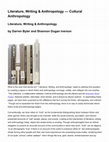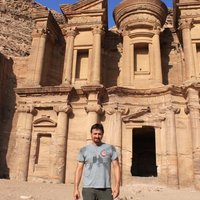Papers by S. Dugan Iverson
Material Encounters and Indigenous Transformations in the Early Colonial Americas: Archaeological Case Studies, 2019
Iverson publicó The Enduring Toltecs: History and Truth during the Aztecto-Colonial Transition at... more Iverson publicó The Enduring Toltecs: History and Truth during the Aztecto-Colonial Transition at Tula en el Journal of Archaeological Method and Theory. 1 Aquí damos a conocer la traducción al español de este artículo. 2 SHANNON DUGAN IVERSON, The Enduring Toltecs: History and Truth during the Aztec-to-Colonial Transition at Tula, Journal of Archaeological Method and Theory 24/1 (2017): 90-116.

Tula, Hidalgo, was an important early Postclassic city that dominated much of central Mexico as w... more Tula, Hidalgo, was an important early Postclassic city that dominated much of central Mexico as well as adjacent regions to its north and west. For many decades,
Tula was thought to be the city that early colonial documents referred to as Tollan, or place of the reeds. It is clear that the Aztec Empire, a later civilization that dominated a much larger area, revered Tollan and connected themselves to the city and its people,
the Toltecs, in various ways. Recent research has questioned whether Tula was indeed the Tollan that the Aztecs revered; instead, Tollan may have been a concept that referred to all of the great civilizations that preceded the Aztecs. These two perspectives, which I frame as the single Tollan/many Tollans debate, have important
consequences for our understanding of the early Postclassic period as well as colonial configurations of power. I argue that to understand the Aztecs’ relationships with their past, and the colonial consequences of those relationships, it is important to shift away from questions of truth. Instead, I concentrate on historical narratives and the social, material, and biological effects that they produced, including the early and late Aztec interventions at Tula. I argue that Jorge Acosta’s data provide evidence for an Early Aztec period termination ritual and a Late Aztec period New Fire ceremony that ushered in a new population boom at Tula. In turn, these connections allowed for the unprecedented rise of the Moctezuma family during the colonial period. This evidence forms part of a broader argument that the two sides of the Tula debate are not mutually exclusive. Rather, they both form part of attempts to control, claim, and revere the past
in the inherently unstable fields of power that characterized the late Postclassic and early colonial periods in central Mexico.

Introduction to Literature, Writing & Anthropology: A Curated Collection of Five Cultural Anthrop... more Introduction to Literature, Writing & Anthropology: A Curated Collection of Five Cultural Anthropology Articles
What is the work that stories do? “Literature, Writing, and Anthropology” seeks to address this question by creating a space in which fiction and anthropology converge, collide, and collapse into one another. This collection, a collaboration between Cultural Anthropology and the literary journal American Short Fiction, features articles, interviews, short stories, and a lecture by eleven authors. In assembling these pages, we have been surprised by the affiliations that form across the fiction, ethnography, and criticism. Though we’ve separated the fiction from the anthropology, there is no way to easily demarcate where fiction ends and anthropology begins.
Articles
The Postmodern Crisis: Discourse, Parody, Memory
by Vincent Crapanzano
Cancer Butch
by S. Lochlann Jain
Stories and Cosmogonies: Imagining Creativity Beyond "Nature" and "Culture"
by Stuart McLean
Death and Memory: From Santa María del Monte to Miami Beach
by Ruth Behar
Beyond Writing: Feminist Practice and the Limitations of Ethnography
by Elizabeth Enslin
Conference Presentations by S. Dugan Iverson

Aztec emperors legitimized their rule by appropriating the Toltec past: they married women from T... more Aztec emperors legitimized their rule by appropriating the Toltec past: they married women from Tula, required that their royal garments be manufactured there, imitated art from the ancient city, venerated Tula in their histories and poetry, and excavated relics from Tula's ceremonial center. These real, manufactured, and imagined ties to the Toltecs had important consequences for the built landscape in the Aztec era and for the later physical and political landscapes of the colonial era. In particular, Aztec ties to the Toltecs influenced Hernán Cortés' decision to grant the Tula region to Pedro Moctezuma, son of the Aztec emperor. This decision meant that the Aztec imperial lineages held economic control of the region well into the colonial era, and that the principal agents of Spanish social change in the early colonial period in Tula were the Franciscan mendicants who settled there, rather than local Spanish encomenderos. How was the Toltec past appropriated, negotiated, and manipulated? This paper considers historical and archaeological data from previous investigations, and presents new data from archaeological excavations conducted in 2013 on two early Franciscan sites. Together, this information seems to point to echoes of Toltec hegemony: an imagined, revered, and contested past that continued to hold influence more than 500 years after Tula's decline.

In 1524, only three years after the military conquest of central Mexico was complete, twelve Fran... more In 1524, only three years after the military conquest of central Mexico was complete, twelve Franciscan friars arrived in New Spain to begin an ambitious religious conversion program. The friars arrived in a territory where landscapes, buildings, and everyday objects (such as foodstuffs and ceramic objects) were already " mythologized " —deeply imbued with supernatural connotations. For the Spanish priests, Indigenous worlds were always potential minefields of spiritual pollution. Therefore, though they often worked very closely with and advocated on behalf of Indigenous peoples, they also attempted to maintain a boundary between their traditions and those of the " pagans. " Using Tula, Hidalgo as a case study, I investigate those attempts at boundary maintenance by comparing material culture from two very early colonial sites, a Franciscan chapel constructed in 1530 and a cathedral built in 1550. This study revealed two important points: first, creativity and innovation happened within material culture of the Indigenous tradition, rather than through imitation or importation of European goods. Second, the comparative contexts showed that Spanish friars were forced to adapt to an overwhelming tide of Indigenous religious traditions, which would permanently impact the shape of Mexican Catholicism.

Archaeological assemblages from two early colonial religious sites at Tula, Hidalgo are nearly in... more Archaeological assemblages from two early colonial religious sites at Tula, Hidalgo are nearly indistinguishable from pre-Columbian assemblages at the same sites. These findings indicate that colonial changes in material culture were much more gradual than we expected, and driven to a surprising degree by Indigenous traditions and aesthetic prerogatives. These data led us to reconsider various models of social change that would adequately account for the observations of material culture at Spanish religious sites. Clearly, we know from documentary sources that the so-called colonial encounter was not an equal exchange of ideas. However, models of top-down power alone could not account for the data in Tula. Conversely, models that posited cultural continuity—an Indigenous " core " with a Spanish colonial " veneer " —seemed inadequate to account for genuine Indigenous relationships with the Church. This paper explores the legacies and problems of several models, including acculturation and syncretism, before positing Judith Butler's concept of resignification as an appropriate model of colonial power and religious change.











Uploads
Papers by S. Dugan Iverson
Tula was thought to be the city that early colonial documents referred to as Tollan, or place of the reeds. It is clear that the Aztec Empire, a later civilization that dominated a much larger area, revered Tollan and connected themselves to the city and its people,
the Toltecs, in various ways. Recent research has questioned whether Tula was indeed the Tollan that the Aztecs revered; instead, Tollan may have been a concept that referred to all of the great civilizations that preceded the Aztecs. These two perspectives, which I frame as the single Tollan/many Tollans debate, have important
consequences for our understanding of the early Postclassic period as well as colonial configurations of power. I argue that to understand the Aztecs’ relationships with their past, and the colonial consequences of those relationships, it is important to shift away from questions of truth. Instead, I concentrate on historical narratives and the social, material, and biological effects that they produced, including the early and late Aztec interventions at Tula. I argue that Jorge Acosta’s data provide evidence for an Early Aztec period termination ritual and a Late Aztec period New Fire ceremony that ushered in a new population boom at Tula. In turn, these connections allowed for the unprecedented rise of the Moctezuma family during the colonial period. This evidence forms part of a broader argument that the two sides of the Tula debate are not mutually exclusive. Rather, they both form part of attempts to control, claim, and revere the past
in the inherently unstable fields of power that characterized the late Postclassic and early colonial periods in central Mexico.
What is the work that stories do? “Literature, Writing, and Anthropology” seeks to address this question by creating a space in which fiction and anthropology converge, collide, and collapse into one another. This collection, a collaboration between Cultural Anthropology and the literary journal American Short Fiction, features articles, interviews, short stories, and a lecture by eleven authors. In assembling these pages, we have been surprised by the affiliations that form across the fiction, ethnography, and criticism. Though we’ve separated the fiction from the anthropology, there is no way to easily demarcate where fiction ends and anthropology begins.
Articles
The Postmodern Crisis: Discourse, Parody, Memory
by Vincent Crapanzano
Cancer Butch
by S. Lochlann Jain
Stories and Cosmogonies: Imagining Creativity Beyond "Nature" and "Culture"
by Stuart McLean
Death and Memory: From Santa María del Monte to Miami Beach
by Ruth Behar
Beyond Writing: Feminist Practice and the Limitations of Ethnography
by Elizabeth Enslin
Conference Presentations by S. Dugan Iverson
Tula was thought to be the city that early colonial documents referred to as Tollan, or place of the reeds. It is clear that the Aztec Empire, a later civilization that dominated a much larger area, revered Tollan and connected themselves to the city and its people,
the Toltecs, in various ways. Recent research has questioned whether Tula was indeed the Tollan that the Aztecs revered; instead, Tollan may have been a concept that referred to all of the great civilizations that preceded the Aztecs. These two perspectives, which I frame as the single Tollan/many Tollans debate, have important
consequences for our understanding of the early Postclassic period as well as colonial configurations of power. I argue that to understand the Aztecs’ relationships with their past, and the colonial consequences of those relationships, it is important to shift away from questions of truth. Instead, I concentrate on historical narratives and the social, material, and biological effects that they produced, including the early and late Aztec interventions at Tula. I argue that Jorge Acosta’s data provide evidence for an Early Aztec period termination ritual and a Late Aztec period New Fire ceremony that ushered in a new population boom at Tula. In turn, these connections allowed for the unprecedented rise of the Moctezuma family during the colonial period. This evidence forms part of a broader argument that the two sides of the Tula debate are not mutually exclusive. Rather, they both form part of attempts to control, claim, and revere the past
in the inherently unstable fields of power that characterized the late Postclassic and early colonial periods in central Mexico.
What is the work that stories do? “Literature, Writing, and Anthropology” seeks to address this question by creating a space in which fiction and anthropology converge, collide, and collapse into one another. This collection, a collaboration between Cultural Anthropology and the literary journal American Short Fiction, features articles, interviews, short stories, and a lecture by eleven authors. In assembling these pages, we have been surprised by the affiliations that form across the fiction, ethnography, and criticism. Though we’ve separated the fiction from the anthropology, there is no way to easily demarcate where fiction ends and anthropology begins.
Articles
The Postmodern Crisis: Discourse, Parody, Memory
by Vincent Crapanzano
Cancer Butch
by S. Lochlann Jain
Stories and Cosmogonies: Imagining Creativity Beyond "Nature" and "Culture"
by Stuart McLean
Death and Memory: From Santa María del Monte to Miami Beach
by Ruth Behar
Beyond Writing: Feminist Practice and the Limitations of Ethnography
by Elizabeth Enslin